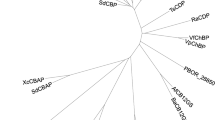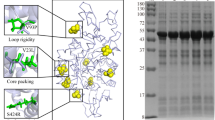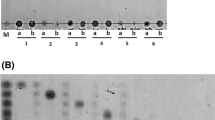Abstract
Clones of a genomic library of Bifidobacterium adolescentis were grown in minimal medium with sucrose as sole carbon source. An enzymatic fructose dehydrogenase assay was used to identify sucrose-degrading enzymes. Plasmids were isolated from the positive colonies and sequence analysis revealed that two types of insert were present, which only differed with respect to their orientation in the plasmid. An open reading frame of 1,515 nucleotides with high homology for sucrose phosphorylases was detected on these inserts. The gene was designated SucP and encoded a protein of 56,189 Da. SucP was heterologously expressed in Escherichia coli, purified, and characterized. The molecular mass of SucP was 58 kDa, as estimated by SDS-PAGE, while 129 kDa was found with gel permeation, suggesting that the native enzyme was a dimer. The enzyme showed high activity towards sucrose and a lower extent towards α-glucose-1-phosphate. The transglucosylation properties were investigated using a broad range of monomeric sugars as acceptor substrate for the recombinant enzyme, while α-glucose-1-phosphate served as donor. d- and l-arabinose, d- and l-arabitol, and xylitol showed the highest production of transglucosylation products. The investigated disaccharides and trisaccharides were not suitable as acceptors. The structure of the transglucosylation product obtained with d-arabinose as acceptor was elucidated by NMR. The structure of the synthesized non-reducing dimer was α-Glcp(1→1)β-Araf.



Similar content being viewed by others
References
Altschul SF, Madden Tl, Schäffer AA, Zhang J, Zhang Z, Miller W, Lipman DJ (1997) Gapped BLAST and PSI-BLAST: a new generation of protein database search programs. Nucleic Acids Res 25:3389–3402
Birnberg PR, Brenner ML (1984) A one-step enzymatic assay for sucrose with sucrose phosphorylase. Anal Biochem 142:556–561
Bock K, Thøgersen N (1982) Nuclear magnetic resonance spectroscopy in the study of mono- and oligosaccharides . Annu Rep NMR Spectrosc 13:1–57
Bock K, Pedersen C, Pedersen H (1984) Carbon-13 nuclear magnetic resonance data for oligosaccharides. Adv Carbohydr Chem Biochem 42:193–225
Bradford MM (1976) A rapid and sensitive method for quantification of microgram quantities of protein utilizing the principal of protein–dye binding. Anal Biochem 72:248–254
Derensy-Dron D, Krzewinski F, Brassart C, Bouquelet S (1999) β-1,3-Galactosyl-N-acetylhexosamine phosphorylase from Bifidobacterium bifidum DSM 20082: characterization, partial purification and relation to mucin degradation. Biotechnol Appl Biochem 29:3–10
Doudoroff M, Barker HA, Hassid WZ (1947a) Studies with bacterial sucrose phosphorylase I. The mechanism of action of sucrose phosphorylase as a glucose-transferring enzyme (transglucosidase). J Biol Chem 168:725–732
Doudoroff M, Hassid WZ, Barker HA (1947b) Studies with bacterial sucrose phosphorylase II. Enzymatic synthesis of a new reducing and of a new non-reducing disaccharide. J Biol Chem 168:733–746
Farkas E, Thiem J, Krzewinski F, Bouquelet (2000) Enzymatic synthesis of Galβ1→3GlcNAc derivatives utilising a phosphorylase from Bifidobacterium bifidum 20082. Synth Lett 5:728–730
Ferretti JJ, Huang TT, Russell RRB (1988) Sequence analysis of the glucosyltransferase A gene (gftA) from Streptococcus mutans Ingbritt. Infect Immun 56:1585–1588
Fournier P, Ruffray P de, Otten L (1994) Natural instability of Agrobacterium vitis Ti plasmid due to unusual duplication of a 2.3-kb DNA fragment. Mol Plant Microbe Interact 7:164–172
Gibson GR, Roberfroid MB (1995) Dietary modulation of the human colonic microbiota: introducing the concept of prebiotics. J Nutr 125:1401–1412
Gottschalk A (1950) Principles underlying enzyme specificity in the domain of carbohydrates. Adv Carbohydr Chem 5:49–78
Henrissat B (1991) A classification of glycosyl hydrolases based on amino acid sequence similarities. Biochem J 280:309–316
Holmes EW (1997) Coupled enzymatic assay for the determination of sucrose. Anal Biochem 244:103–109
Ichikawa M, Schnaar RL, Ichikawa Y (1995) Application of sucrose phosphorylase reaction in one-pot enzymatic galactosylation: scavenger of phosphate and generation of glucose-1-phosphate in situ. Tetrahedron Lett 36:8731–8732
Kabel MA, Kortenhoeven L, Schols HA, Voragen AGJ (2003) In vitro fermentability of differently substituted xylo-oligosaccharides. J Agric Food Chem 50:6205–6210
Kagan BO, Latker SN, Zfasman EM (1942) Phosphorolysis of saccharose by cultures of Leuconostoc mesenteroides. Biokhimiya 7:93–108
Kawasaki H, Nakamura N, Ohmori M, Amari K, Sakai T (1996a) Screening for bacteria producing sucrose phosphorylase and characterization of the enzymes. Biosci Biotechnol Biochem 60:319–321
Kawasaki H, Nakamura N, Ohmori M, Sakai T (1996b) Cloning and expression in Escherichia coli of sucrose phosphorylase gene from Leuconostoc mesenteroides No. 165. Biosci Biotechnol Biochem 60:322–324
Kitao S, Nakano E (1992) Cloning of the sucrose phosphorylase gene from Leuconostoc mesenteroides and its overexpression using a ‘sleeper’ bacteriophage vector. J Ferment Bioeng 73:179–184
Kitao S, Sekine H (1992) Transglucosylation catalyzed by sucrose phosphorylase from Leuconostoc mesenteroides and production of glucosyl-xylitol. Biosci Biotechnol Biochem 56:2011–2014
Kitao S, Sekine H (1994a) α-d-Glucosyl transfer to phenolic compounds by sucrose phosphorylase from Leuconostoc mesenteroides and production of α-arbutin. Biosci Biotechnol Biochem 58:38–42
Kitao S, Sekine H (1994b) Syntheses of two kojic acid glucosides with sucrose phosphorylase from Leuconostoc mesenteroides. Biosci Biotechnol Biochem 58:419–420
Kitao S, Ariga T, Matsudo T, Sekine H (1993) The syntheses of catechin-glucosides by transglycosylation with Leuconostoc mesenteroides sucrose phosphorylase. Biosci Biotechnol Biochem 57:2010–2015
Kitao S, Yoshida S, Horiuchi T, Sekine H, Kusakabe I (1994) Formation of kojibiose and nigerose by sucrose phosphorylase. Biosci Biotechnol Biochem 58:790–791
Kitao S, Matsudo T, Saitoh M, Horiuchi T, Sekine H (1995) Enzymatic syntheses of two stable (−)-epigallocatechin gallate-glucosides by sucrose phosphorylase. Biosci Biotechnol Biochem 59:2167–2169
Kitao S, Matsudo T, Sasaki T, Koga T, Kawamura M (2000) Enzymatic synthesis of stable, odorless, and powdered furanone glucosides by sucrose phosphorylase. Biosci Biotechnol Biochem 64:134–141
Kitaoka M, Hayashi K (2002) Carbohydrate-processing phosphorolytic enzymes. Trends Glycosci Glycobiol 14:35–50
Koga T, Nakamura K, Shirokane Y, Mizusawa K, Kitao S, Kikuchi M (1991) Purification and some properties of sucrose phosphorylase from Leuconostoc mesenteroides. Agric Biol Chem 55:1805–1810
Kogure M, Mori H, Ariki H, Kojima C, Yamamoto H (1997) Determination of sucrose using phosphorylase in a flow-injection system. Anal Chim Acta 337:107–111
Maestre E, Katakis I, Domínguez E (2001) Amperometric flow-injection determination of sucrose with a mediated tri-enzyme electrode based on sucrose phosphorylase and electrocatalytic oxidation of NADH. Biosens Bioelectron 16:61–86
Muramatsu K, Onodera S, Kikuchi M, Shiomi N (1993) Purification and some properties of β-fructofuranosidase from Bifidobacterium adolescentis G1. Biosci Biotechnol Biochem 57:1681–1685
Park JK, Keyhani NO, Roseman S (2000) Chitin catabolism in the marine bacterium Vibrio furnisii. J Biol Chem 275:33077–33083
Russel RRB, Mukasa H, Shimamura A, Ferretti JJ (1988) Streptococcus mutans gtfA gene specifies sucrose phosphorylase. Infect Immun 56:2763–2765
Silverstein R, Voet J, Reed D, Abeles RH (1967) Purification and mechanism of action of sucrose phosphorylase. J Biol Chem 242:1338–1346
Sprogøe D, Van den Broek LAM, Mirza O, Kastrup JS, Voragen AGJ, Gajhede M, Skov LK (2004) Crystal structure of sucrose phosphorylase from Bifidobacterium adolescentis. Biochemistry. (in press)
Tedokon M, Suzuki K, Kayamori Y, Fujita S, Katayama Y (1992) Enzymatic assay of inorganic phosphate with use of sucrose phosphorylase and phosphoglucomutase. Clin Chem 38:512–515
Trindade MI, Abratt VR, Reid SJ (2003) Induction of sucrose utilization genes from Bifidobacterium lactis by sucrose and raffinose. Appl Environ Microbiol 69:24–32
Van den Broek LAM, Ton J, Verdoes JC, Van Laere KMJ, Voragen AGJ, Beldman G (1999) Synthesis of α-galacto-oligosaccharides by a cloned α-galactosidase from Bifidobacterium adolescentis. Biotechnol Lett 21:441–445
Van den Broek LAM, Struijs K, Verdoes JC, Beldman G, Voragen AGJ (2003) Cloning and characterization of two α-glucosidases from Bifidobacterium adolescentis DSM20083. Appl Microbiol Biotechnol 61:55–60
Van Laere KMJ, Hartemink R, Beldman G, Pitson S, Dijkema C, Schols HA, Voragen AGJ (1999) Hydrolase and transgalactosylation activity of Bifidobacterium adolescentis α-galactosidase. Appl Microbiol Biotechnol 52:681–688
Van Laere KMJ, Hartemink R, Bosveld M, Schols HA, Voragen AGJ (2000) Fermentation of plant cell wall derived polysaccharides and their corresponding oligosaccharides by intestinal bacteria. J Agric Food Sci 48:1644–1652
Verhoef R, Waard P de, Schols HA, Rättö M, Siika-aho M, Voragen AGJ (2002) Structural elucidation of the EPS of slime producing Brevundimonas vesicularis sp. isolated from a paper machine. Carbohydr Res 337:1821–1831
Weimberg R, Doudoroff M (1953) Studies with three bacterial sucrose phosphorylases. J Bacteriol 68:381–388
Author information
Authors and Affiliations
Corresponding author
Rights and permissions
About this article
Cite this article
van den Broek, L.A.M., van Boxtel, E.L., Kievit, R.P. et al. Physico-chemical and transglucosylation properties of recombinant sucrose phosphorylase from Bifidobacterium adolescentis DSM20083. Appl Microbiol Biotechnol 65, 219–227 (2004). https://doi.org/10.1007/s00253-003-1534-x
Received:
Revised:
Accepted:
Published:
Issue Date:
DOI: https://doi.org/10.1007/s00253-003-1534-x




